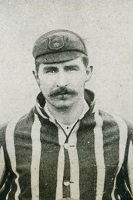Some Notes on the Organ at St Lawrence Church, North Wingfield

In 1727 parishioners organised a petition against Lemuel Gladwin’s proposal to install an organ in the church, stating that to would be ‘of no advantage’ but would only put them to more expense. The petition was obviously ultimately unsuccessful, as thirty years later, Mr Anthony Greatorex (1730-1814) was organist at North Wingfield. The parish registers record the Greatorex family living at Locko Lane until circa 1766, when Mr Greatorex moved to Leicester to become organist of St Margaret’s church. While the family were living in North Wingfield, Thomas, son of Anthony and Ann Greatorex of Locko, was baptised at North Wingfield on 22 October 1758. Thomas Greatorex became a distinguished organist and conductor, and is buried in Westminster Abbey.


The organists who succeeded Anthony Greatorex for the next 100 years are unknown to me, but the rector from 1799 to 1822 was the Rev Henry (Harry) Hankey who was a keen musician. A skilled violin player, he led the band at the third Chesterfield Subscription Concert, held at the Assembly Room at the Angel Inn (Derby Mercury 19 November 1818). It seems likely that he would have made sure that there was music played in his church. It may not have been organ music, though, as when the Rev Samuel Butler inspected the church on 10 July 1823 he reported that the organ was out of order. At this time the organist’s salary was set at £8. (M.R. Austin (ed.) The Church in Derbyshire in 1823-4. Derbyshire Archaeological Society Record Series v.5, 1972).
Twenty years later the organ was in some sort of working order again, but in May 1866 a ‘Lover of Music’ wrote to the Derbyshire Times complaining that “sometimes I could fancy it thought itself grown too old in the service, and fain would be mute, rather than compel anyone either to sing or listen to it. Sometimes it seemed something like the squeak of child with the whooping-cough, and the end of a tune generally died away with a sound resembling something between a hiss and a groan” (Derbyshire Times 16 May 1866).
In the mid nineteenth century George Cupit of Danesmoor was organist. Along with his salary Cupit had some land courtesy of his position, and also worked as a joiner for the Clay Cross Company. He died 24 November 1886 but had probably given up his musical duties before this date, as Mr Whitworth, and then the curate’s sister Miss Alice Wood, both subsequently took on the role of organist before 1886, the latter residing in the parish from 1879 to 1886. (Interview with Thomas Allibone in Derbyshire Courier 15 February 1910).

After 1890 organists had a much better instrument to play on. On 21 June 1890 the Derbyshire Times reported the opening of the new organ at North Wingfield church. Three special opening ceremonies were arranged to raise funds to pay for the new instrument which had cost £435. It was been built by C. Lloyd & Co. of Nottingham, and transported to North Wingfield by rail to Clay Cross station.

Until shortly before his untimely death aged 52 in 1903, the organist was Mr W.H. Newbould, the headmaster of Tupton Boys’ School. The rector wrote in the parish magazine “Mr Newbould had been organist and choirmaster here from Mr Darby’s days, and had made the services, from the musical point of view, among the best in the neighbourhood.” (Thirteen years at North Wingfield: a record of events compiled from the parish magazine from 1897 to 1910 (n.d.), 21).
Mr Newbould was succeeded by Mr Herbert Butterworth (1868-1946), who had been organist at Clay Cross, and also worked as an accountant for the Clay Cross Company. For a time Mr Herbert also had a quadrille band, led the Clay Cross Volunteers Band for sixteen years, and was conductor of the Clay Cross Choral Society for six years. He gave regular recitals round the district in aid of church funds. Mr Butterworth resigned from his position in 1941, after nearly 40 years.
I leave the last word on the organ to an anonymous note on a church leaflet:
“Over the last hundred years the instrument has been cared for by the original builders, then by Henry Willis & Sons, and currently by A. Cragg Organ Builders (Midlands). In the early years of the incumbency of Canon Joyce the organ was completely overhauled including the replacement of the original pedal board, and then late in 1980 the instrument was, as many members of the congregation will recall, cleaned and overhauled at a cost of £3,253. So with loving care and attention the organ built in 1892 [sic] should continue to give good service in leading the worship well into the 21st century. Let us hope that there will be organists to see that this will be so.”
























































You must be logged in to post a comment.